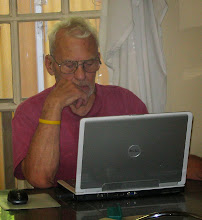Remembering Juarez, MX
I just saw a news report revealing that 3,000 persons have been murdered in Juarez, Mexico this year.
I am saddened.
I first visited Juarez, Mexico sixty years ago. At that time we walked across a short bridge over the Rio Grande river, the dividing line between Juarez and El Paso, Texas. Young Mexican boys stood in the knee deep water, facing the bridge. They had fashioned sort of paper funnels and attached them to long, bamboo fishing poles. They pointed their devices toward the bridge where passersby tossed coins. Many times the boys caught the coins with their devices. If they missed, they immediately went to their knees and felt for the coins in the muddy river bottom.
We found the people of Juarez friendly, welcoming to Americans, and anxious to sell something. We bought things. Tequila, leather goods, and all sorts of craft items. We enjoyed delicious food at unbelievably low prices.
Through the years I returned to Juarez many times. The short bridge is gone, as are the coin-catching boys. The muddy bottomed river replaced with a concrete-lined canal in which the water is swift and dangerous. There are three bridges today, long, modern bridges which carry large numbers of pedestrian and auto traffic.
News reports today describe Juarez as being "just south of El Paso". In reality, Juarez and El Paso are one large city, separated by a small river. For generations - centuries, actually - residents of the two cities have passed back and forth. Many have married persons from the other side of the border, so there are numerous families split by the border.
At one time the total metro area was entirely in Mexico. In 1854, the U.S. needed a better route through which to build a railroad toward the west. In the Gadsden Purchase, land between the then existing U.S. border and the Rio Grande were purchased from Mexico, and the border moved south. Remembering this makes it easier to understand why many local residents oppose construction of a fence along the border.
Going south you just drive into Mexico. Vehicles are selected randomly to check for what is being brought into Mexico.
On the U.S. side, U.S. Customs has a much more rigid inspection system. The state of Texas demands payment of taxes for any liquor brought into the state.
We visited Juarez to dine, shop, and just to have fun. We made friends with Mexicans at the big Mercado where we bargained for the wares of Mexican artists and craftsmen. Naturally there were some rip-offs among the many great deals. But prices were low so no one was ever hurt too badly.
I went to Mexico for Dental work performed entirely to my satisfaction at perhaps 80% lower than U.S. prices.
We can not go to Juarez today. It is just too dangerous. I often wonder about the fate of some of the people we once knew. I wonder about the many small businesses which depended on American tourist trade.
Not surprisingly, I get angry when I see Americans smile as they confess to using illegal drugs. I know they just think the are outsmarting the DEA. But there is so much more to the story.
Perhaps decriminalizing drugs would solve the problem. I don't know.
What I do know is that a tragedy has befallen a lot of good, decent people who happen to reside in the path of drugs moving north and cash moving south.
When will it end?
Friday, December 17, 2010
Subscribe to:
Post Comments (Atom)

No comments:
Post a Comment